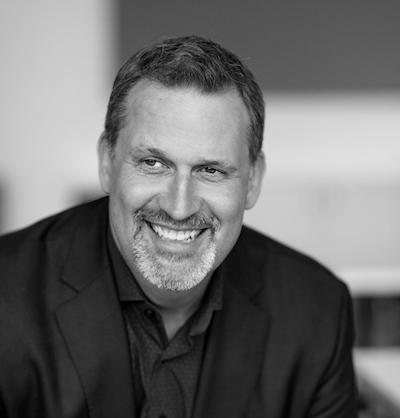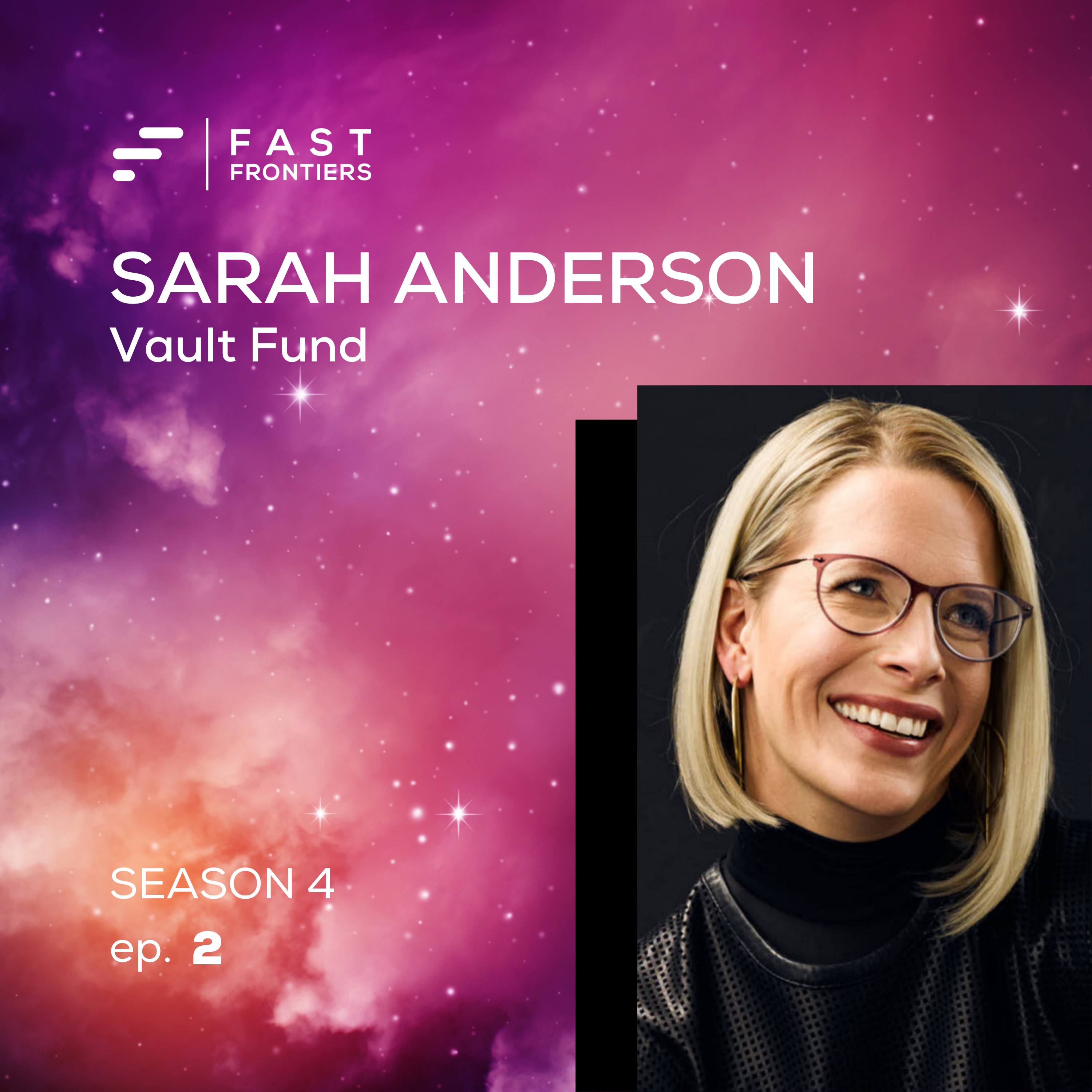S4 Ep 2. Sarah Anderson: Vault Fund
- 0.5
- 1
- 1.25
- 1.5
- 1.75
- 2
Tim Schigel: Welcome to Fast Frontiers. I'm your host, Tim Schigel, Managing Partner of Refinery Ventures. In this episode, we're talking with Sarah Anderson, Founder, and Partner of Vault Fund. In this episode, we're going to dive into what makes a venture studio? Sarah will help us differentiate between a typical venture fund, venture studios, accelerators, and incubators. She dives deeper into the various venture studio models that we are seeing in the market and includes her thoughts on how a studio should be set up with fair and incentivized equity structures. The biggest theme or, so what? I hope you take away from this conversation is that venture studios are a unique and viable way to start companies by facilitating the zero to one stage company creation, backing experienced hyper- growth entrepreneurs with domain expertise. Venture studios can create tremendous successes. Please enjoy my conversation with Sarah Anderson. All right. Today, we're going to have a fun session with Sarah Anderson, The Founding Partner of Vault Fund. Sarah and I were able to work together starting in 2013, a little while ago, when I talked her into helping us launch Cintrifuse. But before that, Sarah went to school, University of Florida, where she was an NCAA pole vaulter, a hobby that she continues to do to this day, which is pretty awesome. And we're going to look for some parallels and metaphors in that. And then her MBA from UCLA. Sarah was in the investment banking world on the west coast with RBC Royal Bank of Canada and JP Morgan, dealing in the tech and media industry. Her husband's family was from Cincinnati. They moved back here to the area, and I started helping out with launching Cintrifuse, and people said, "You have to meet Sarah Anderson." I needed somebody to help us get it off the ground. It worked terrifically. I was there for four years, turned over the baton to Sarah in the fund manager for the remaining years up until recently. So Sarah, welcome to Fast Frontiers.
Sarah Anderson: Thanks. I'm so excited to be here. I mean, my goodness, when you say that, I feel like I was a baby when we first started working together. It's a long time ago.
Tim Schigel: Yeah. I looked at your bio that you wrote. And I was like, "What? Eight years? That's crazy."
Sarah Anderson: Crazy.
Tim Schigel: So Cintrifuse, we won't spend a ton of time on it, but it is important to kind of, I think, for context to explain it and how that prepared you for and gave you the insight that led to doing Vault Fund. But first of all, what's interesting about this, this is Fast Frontiers, after all. So we're looking for new innovative ideas and concepts and entrepreneurs on the bleeding edge, and Vault Fund is the only, globally the only fund- to- fund focused specifically on venture studios within the venture capital early-stage growth world. So that's a pretty exclusive group, exclusive to one.
Sarah Anderson: Well, and it either makes me crazy or brilliant. So time will tell.
Tim Schigel: That's a good position to be in because I think you're really onto something. And so we'll dig into that, but first of all, tell our listeners about Cintrifuse and your role and some of the things that you learned while at Cintrifuse.
Sarah Anderson: Yeah. So I think one of the keys to Cintrifuse is, all of our investors are large corporations. And we work very hard alongside those corporations to help them with their innovation strategies. And one of the key theses that we were testing at Cintrifuse was by connecting these corporations with the venture investors themselves. Instead of doing individual pilots with startups, they were able to see across a much broader landscape of innovation, startups, categories and really help that innovation effort become more efficient. And so-
Tim Schigel: The large companies in Cincinnati, Procter & Gamble, Kroger, Western & Southern Insurance, Great American Insurance, they were the draw. They were the honeypot that we use to draw those early-stage venture firms to the region, give them a reason to come. And we had two funds over a hundred million under management. Tell us about some of the funds, the venture funds that Cintrifuse was looking for, and the relationships you built.
Sarah Anderson: Yeah. So while I think one of the best case studies is actually a relationship that you forged, Tim, when you were there with Greycroft as a good example. Greycroft is one of the prominent investors, venture investors, early-stage between New York and LA. And they had a very strong interest in a startup, a local startup in Cincinnati called Everything But The House, which they ended up leading the early-stage rounds for Everything But The House, they became very active in the region. They have strong insights across heck and both consumer tech as well as B2B tech. And because of that, they've been a really strong partner to a lot of our corporate LPs. So that is the type of GP relationships that we were trying to build between fund one and fund two. I think another good example is Lerer Hippeau out of New York, an early- stage venture investor, strong performance, strong returns had been engaged with the region through Brandery for years, became a formal GP relationship with Cintrifuse, and has been plugging into P & G, Kroger, AAA, Smuckers, kind of across the board to help them understand different industries and what's going on in those industries. So those are two really good examples of some of the GP relationships that we had between fund one and fund two. And I think one of the biggest differences and kind of leading into the strategy of Vault is when we launched fund two, we really double down on this innovation effort with some of our corporations. It was really the category that was working well within our Cintrifuse strategy. As part of that, we started doing a lot of fielding different types of innovation and even getting more specific and deeper into the innovation efforts within these large corporations, working with multiple business units, working with multiple teams. And one of the things we quickly realized is a lot of the corporations, they have very specific needs. They're not just general data analytics or general marketing branding, et cetera. They are specific molecules that they need or specific CRM capability. So we started looking into where can we do more co- design and co- create work. And I think those are some of the new relationships we forged out of fun, too. And that was really what started my thinking around the strategy that we're using for Vault now.
Tim Schigel: When did you start looking at or getting introduced to people or funds that were the venture studio model?
Sarah Anderson: Well, so the first one, of course, was in 2015 when you were there, Atlas Venture. So a lot of people don't think about them as a venture studio, but they very much are. They're simply on the molecule side, right?
Tim Schigel: Good point.
Sarah Anderson: But they're buying IP, and they're scaling, developing it, testing it, putting resources around it, just like a venture studio would. We started making a big push into the venture studio landscape back in 2018, 2019. One of the first venture studios I met was Atomic Labs. And I was very impressed early on with their capabilities around building just the zero to one build. And also, their performance really stood out among the pipeline of traditional venture funds we were looking at at the time. So that was kind of a push to look more across the landscape. And we talked to professionals at Cintrifuse. We probably talked to at least 20 or 30 studios to try and get a sense for who had really strong expertise working with corporations. It's not super easy to work with corporations all the time. So having that experience and those partnerships and understanding how those teams work was really important. We were also looking at which venture studio partners would align really well with some of the core businesses among our LPs to kind of plug into that bench of talent that they needed. But we took our time. We really landscaped the industry over the next two or three years, and we made a couple of commitments. There's still a lot of work going on at Cintrifuse now in the venture studio space. I think a lot of it is driven by our LP Partners, who are becoming more and more interested in the space, which is good.
Tim Schigel: Let's back up back to definitions. So help people understand the difference between venture fund versus venture studio versus even an accelerator. What's the same and what's different?
Sarah Anderson: Yeah. So a traditional venture fund. They're an early stage because that's all that we really focused on at Cintrifuse. Traditional venture fund, we'll invest anywhere from $250,000 up to five, 10 million into an existing company, an existing company that is raising external funding. They are paid in preferred equity. The terms always differ, but typically they're getting anywhere from 5% ownership to 10 to 15% ownership in the round that they participate in, then they do pro rate. A venture studio, at least the venture studios that Vault is focused on and where I've had, I think the most experience, are those studios that are doing formation work. So they're acting as the founders of these companies. So they are creating novel equity within the studio. Typically the studios get paid in both common, as well as preferred, and their ownership because they are an entity that acts as a founder. Their ownership typically ranges anywhere between 30 and 60% out formation. And we can talk about how that changes over time as they go out and get external funding. An accelerator very different. And the definitions around venture studio, depending on who you talk to, will be different. The spectrum is very broad, but I'm telling you how Vault defines venture studio. Some accelerators do call themselves venture studios. Some incubators do call themself ventured studios. The key difference, an accelerator is a time- bound entity that is investing typically, call it $100,000, maybe $200,000 for about 6% ownership. They take them through a dedicated kind of training session, development session, three months, six months, after that they go out to raise external funding. It was a company before it came into the accelerator, and it's a company now that it's going out of the accelerator. Accelerators are investing in existing companies, just like traditional venture. An incubator is very similar, but an incubator is very similar to an accelerator, but an incubator is just not time- bound. So an incubator will provide services. Sometimes they will provide capital. And for those services and capital, they are getting a percentage of equity that they are investing in or providing services to existing companies with existing founders. Does that make sense?
Tim Schigel: Good. So if you're an entrepreneur, how should an entrepreneur think about venture studios?
Sarah Anderson: So an entrepreneur, typically, venture studios are created by entrepreneurs. So like Scott Dorsey at High Alpha is a really good example. Jack Abrams at Atomic Labs is a really good example. Entrepreneurs can create studios. Instead of doing one thing, they're doing a whole portfolio of things. Founders that want to go into a venture studio, typically how that relationship works. And there's a whole bunch of different structures. And I think that the industry has not aligned on a specific structure, but typically a founder that might have an idea or expertise in a specific category or interest in a specific category would align with a studio that is currently working in that space. They would come in early days. Sometimes is a little bit later after the idea is baked, but that studio helps them as a co- founder. So the studio takes care of a lot of the non-visionary things that go into early days of developing a company. They do the nuts and bolts around programming, development, user experience, testing, leading indicators, unit economics, all of the back office, finance, getting legal docs set up. They'll even do BD sales work, early partnerships, things like that. They are your co-founder essentially early days. Now a founder that wants to basically take a company that's kind of baked and scale it, then they have to think about the studio a little bit differently. Studios, the founder they're coming in as a co- founder, but a later stage co-founder.
Tim Schigel: How is this introduction of studios going to impact the venture landscape generally? Is this the future of venture? Are more and more venture firms going to have this company formation model, do you think, or is this going to be a subsegment and sort of a niche?
Sarah Anderson: That's a good question because I've thought about this a lot. I mean, I think like from mine, and I'm biased, I am biased because I am very bullish on the studio category. Being an LP in the studio space has so many advantages. However, studios are hard, they're hard, and they're risky. And so what we have seen as several traditional venture funds who do want to create the studio environment. And a lot of that is because they have ideas. They see a lot in the industries that they're in, and they have access to talent, and they want to create companies either to solve solutions that they don't find in the marketplace or because of the economics of being a founder, like a Snowflake was created inside of Sutter Hill, a huge return to Sutter Hill. You see the same thing with like a 5AM and therefore 59 program.
Tim Schigel: So Snowflake went public a year ago in 2020. They're basically a future cloud- based data warehouse. And it's probably selling them short in terms of how they would define it. It went public at about a hundred billion dollar market cap currently at $77 Sutter Hill invested $200 million, and their return was about $12 billion.
Sarah Anderson: Well, the Mike Speiser was a venture partner within Sutter Hill that founded the company. And this is a good example. I'd add assets that Sutter Hill still own 20% of Snowflake. And that is rare in traditional venture. The only reason is because they formed Snowflake from within Sutter Hill. So we have seen this. I think the biggest challenge and whether this becomes more mainstream among venture funds is the fact that it is hard. And the margins on venture studios internally are not as high as the margins on management fees. You have to hire enough people to grow and scale multiple companies. You're focused on that zero to one build. So you end up having a bunch of talent that is much deeper than what you would normally find in a traditional venture fund partnership. And you have to pay for those people. And so it becomes expensive.
Tim Schigel: Yeah, well, that also kind of leads to a question, however, which is the structure of a venture studio because you mentioned Atlas at the beginning, and I think they're great. Their formation activity just happens out of their main fund. Whereas many of the venture studios are typically somebody who calls themselves a venture studio has a fund and then has a studio attached to it. And the ownership and the investor base may be different, which has some advantages but also some disadvantages. So is there a predominant model that you've seen?
Sarah Anderson: Oh, well, so I've seen three models, and this gets back to you. And I think one of the reasons that you don't see more institutional investors participating in this category is because it really hasn't aligned structurally on a specific context. I think it takes a long time to understand some of these venture studio structures and the cash inflows outflows you'll have decisions are made. But the three structures that I've seen, one is this holding company model. It has a lot of advantages, no fees attached to it. It raises a seed round, a series A around, et cetera. Typically by the time it gets to a B or C round, there is enough revenue and income coming from the former company is to kind of fund the operations of the holding company to continue developing. It's this one structure. The second structure is this what you mentioned, Atlas Venture, Atomic also employs the structure, it's a typical two and 20 model where the 2% fee that LPs would normally pay, goes to the operations of this bench of talent. And they create it all internally. So all stays within the fund. The third structure that seems to be emerging, which is a little bit wonky, or it takes a lot longer to understand, and there's more nuance around it, is this dual entity structure. There is an operating company that is the studio that is doing the creation work. And then there is a fund that sits over top of it. And the relationship between the fund and the operating company is different. No matter what studio you talk to the employees, a dual entity structure is different. Sometimes the fund is the only capital into the studio. Sometimes the studio has a separate budget. The fund is investing externally. Sometimes you get a percentage of capital for a percentage of ownership, but at the end of the day, a lot of times in that structure, the pass-through ownership from this studio that's doing the company creation into the fund, which is the only thing that the LPs can access usually, is not as advantageous. So again, this is the riskiest asset class you could invest in. This is the riskiest stage. You have no data. You have ideas only. You are depending on the builders to create a machine- like effect wash, rinse, repeat. And they typically do that within the same category. But in order to reward LPs for the risk that they're taking, you have to incentivize them with ownership. And so, it is a risk- reward balance. In my mind, a lot of times as dual entity structures on a pass through basis just are not able to provide early, early, early- stage LPs with the reward that would be commensurate with the risk they're taking at this stage. In my opinion.
Tim Schigel: And issue with the structure, I guess, is how far that studio can fund the company. Do they fund it through pre-seed, seed, series A at what point do they require, or the startups require right up around new rounds led by new sources of capital, later- stage venture funds?
Sarah Anderson: So typically, what we see is a lot, and these studios are getting bigger. So as the studios are able to demonstrate traction and performance, there is more institutional investors coming into cherry- pick them. So we recently saw like $110 million being raised by High Alpha, $260 million raised by Atomic. You're starting to see a hundred million dollar plus, and of course, Atlas there at $300, $400 million now. But they're staying there. I mean, that's about the right size for them. Typically, at least on the tech side. So life sciences tends to be a little bit more lifecycle investing. They aren't necessarily going out for external funding on some of the companies they develop. But on the tech side, a lot of times, what we see is there'll be like an initial check of $250 to $500,000. And that's the formation capital. That's a test of the idea. See if it has legs. After that, they do have typically another traunch. And this depends on how big their fund is, but typically they will invest maybe two and a half, $5 million, and that will be your first institutional round. It does not go external. It does not go outside of the studio. After that round, and that may be called the seed round, let's just say, they will go outside of the studio for a series A. This is after the company has data. They have an MVP. They usually have product- market fit. At that point, they're going out for external funding. So they're much more baked usually than what you would see in a typical series A round. And then studios, depending on how much funding they have, they will exercise pro rata usually into the mid- stages. So, series B, series C. I haven't seen it after series C. That's the latest I've seen.
Tim Schigel: Is there anything you mentioned High Alpha, and Scott Dorsey was on Fast Frontiers earlier season. And they're in Indianapolis, other studios you've seen on the coast. Is there anything from any advantage or kind of context to geography? Does geography come into play at all?
Sarah Anderson: So there is a theory which I haven't seen play out, but I'm really interested in how, because there are a lot. Like in the studio space, there's this body of studios, High Alpha being one that they were formed back in like 2013, 2015, they have some performance, they're able to show some traction and their portfolio, et cetera, there's a huge long tail, very long tail. There's not a lot of barriers to entry to creating a studio. It's not that much capital. Take Cincinnati, for example. In areas where there's not as much of technology infrastructure or a startup infrastructure or startup funding, studios are able to coalesce the tech talent to work across multiple opportunities. So it creates more stability among the top tech talent that is in those regions. And I have heard this for basically tier 2, tier 3 geographies that studios could create a very strong model around new company development, new tech company development. And I think in the era post COVID, where there is a lot more remote work and people are moving into geographies outside of their job requirements, this becomes much more prominent. And it's not just in the United States, but these are also areas that are being covered by studios globally that have historically had good tech talent, but they haven't been able to coalesce the tech talent into, kind of a central body that is able to allow those technologists to go from company to company more easily.
Tim Schigel: That's a great point. And some of the studios develop certain type of capability that can then be leveraged across any company they create. So I'm thinking of one where the studio itself and the original founders and management are really good at customer acquisition. So whatever company they're creating, they know how to acquire customers online. So, as an entrepreneur, as a startup, that's a risk that you can check off and say, "Oh no, we already know how to do that." Now we may not do it in this vertical yet, but we know how to do it in a lot of other verticals, and we're going to apply it to this problem.
Sarah Anderson: And you see that a lot. They have core capabilities that they're employing across multiple startups.
Tim Schigel: That seems like a key advantage for any student.
Sarah Anderson: Well, in one of the things that I love about the studio model is studios are really... They have core insights. And instead of applying those core insights to a single entity, a single effort, they're able to really test leading indicators. So they know within that process earlier what they should be looking for and what they should be seeing. So there is a story with a studio. But I know really well, they had a huge exit, and they knew within the first two weeks that this company was going to be an outlier, and it was. But here's the key difference. Traditional venture, you're investing money. You're sitting on a board, you're talking to the founder, and you're a partner to the founder, but you're not the founder. Studio, you're the founder. So this whole notion of predictability, control, information arbitrage in the studio model is real. And it's almost a step change from what you see in traditional venture. And it's starting to come out in the numbers, null numbers is, which I think is a big challenge in the venture studio space. But we should talk about just like what are the industry numbers? What are the industry benchmarks? Because they're kind of hard to find, and they're very anecdotal.
Tim Schigel: Yeah. Most venture firms will benchmark themselves according to the Cambridge venture benchmarks. So that's a challenge for these venture studios, isn't it? I mean, in what sense they can put themselves in those benchmarks? By the other hand, seems like that's a need out there to be able to benchmark themselves against each other, like kinds.
Sarah Anderson: Yes, exactly. Because a lot of the feedback and some of the pushback I get, and rightfully so is, "Hey, there's some traction." You see Gephi, you see Hems, you see like even Madrona. And these are outliers of big splashy exits. But the key with the venture studio space is you don't have to have those big splashy exits because guess what? They own 30 to 60% of these companies from inception. So, of course, I'm preaching it on the high mountain because it's what I see. It's been my experience at Cintrifuse and at Vault, but there's not industry-level data, and it drives me bonkers. So the industry data that has come out, so GSSN is a Global Startup Studio Network. They did publish last, I think it was last year, some performance data from studios, but the, in value on that performance data was super low. And remember I said, like the studio category, there's this leading body of studios that have performance. They were created around 2013 to 2015. So they're coming up on their ten-year anniversary. They can get through a full cycle. They're not all a bunch of those. So when you're actually trying to talk about track record and performance, a lot of it currently is anecdotal. Because if you do try to put together those industry data points, they're just going to be a small dataset. So the performance that we have seen and what GSSN came out with late last year was net average IRR for the venture studio industry was 53%. And that mirrors very closely what we're seeing from the Cintrifuse portfolio of studios. So to me, that is confirmatory, but the data's super early, and it's really hard to use it. So you tend to look at these exits from the ownership percentages and the returns to the studios, and you're like, "Okay, it all seems to match up." But what I'm super interested in is not the outliers, but how are these just normal exits $150 million, $200 million exit? How are those returning to the studios? Because there's a lot more of those. And I can tell you that it's a handsome return to the studios because their ownership and their entry evaluation.
Tim Schigel: Yeah. And if the top core tile kind of result is a return three extra fund net to investors, and even an average investment return, your whole fund-
Sarah Anderson: Exactly.
Tim Schigel: ...you are in high cotton. And we did see that with Atlas. We saw that with Atlas. I think what the fund we invested in was 2015, and the first exit returned the fund, right?
Sarah Anderson: Well, yeah. I mean, their ownership is very high. And Atlas, I think also, flagship, like these are really great examples. On the life sciences side, they're developing molecules, and it's a highly regulated process, but the ability to, again, zero to one build is so important. It's so critical to get companies launched and off the ground. You're creating novel equity. And right now, you're creating novel equity in a seller's market, which is great. But Atlas is a really great example where they have that machine effect. Zero to one build exit. And they know how to do it. And they have the appropriate people in their bench of talent to circle those companies and either get them to an exit or in a studio space you do see a high loss ratio on ideas. So you're constantly testing.
Tim Schigel: At the high loss, rate is at a low dollar amount.
Sarah Anderson: Yeah. That's a really good way to put it. I mean, it's been our experience, and I think that's one of the reasons too I'm so bullish on the category. It's a very early emerging category. There's just not a lot of data, and it's not a good category for investors that don't have experience here, but the experience that I've had and that we've had in this category indicates that there's just an incredible opportunity. So that's what Vault is focusing on.
Tim Schigel: I've always been a fan of. There is always an ongoing debate about kind of the profile of a venture capitalist in terms of being an operator or being an attorney or an accountant, or what have you. And there's examples of both successes on both sides, but I've always had the bias towards operator. I think of myself as more of a tech entrepreneur. It seems like that also aligns with the venture studio managers and owners is that they all have strong operating backgrounds. Is that right?
Sarah Anderson: Yeah. I think, well, and they necessarily need to, I wouldn't say all of them do because remember that long tail, I mean, you definitely have people that are emerging that don't have the operational background, but they need to have experience with scale and exit. Because if you own 100% of something that's not valued, is $0 in valuation. So $0 that you owe. And so you have to have some experience getting companies to exit. And that is necessarily usually people that have been prior operators and have had good successful exits, but Tim, you would fit really well in that category.
Tim Schigel: I need to find one.
Sarah Anderson: Are you thinking about creating a studio, refinery studios? That'd be great.
Tim Schigel: Oh, well, you never know. So first studio managers out there that are listening, there's ones who are listening, if you could, if there was anyone thing you'd like to see them do or do differently, what would it be?
Sarah Anderson: I think one of the key topics right now in the industry is just compensation and fairness. And so I mentioned earlier, this is one of the riskiest categories to invest in. And the risk- reward profile is something that we look at quite a bit, and it needs to be fair. And when I say that it needs to be fair across the LPs, but it also needs to be fair to the studio partners and the founders that they're bringing in. And so what is fair is very debatable, but I wish that we see a lot of studio partners launching a studio coming out to raise from traditional LPs, and they are only compensating those LPs with a traditional level of ownership. So I think that that's one of the pieces that I have been struggling with the most is I like when I see models that feel very fair across the board to all the parties involved, it makes me a little bit disheartened when I do see really talented studio partners coming out and providing, the LPs provide all the risk capital for 10% ownership. And that makes me frustrated. So I would just say, whatever structure you align on and whatever structure the studio partner feels like they can work within, please finish to make sure that all of the work capital ownership, et cetera, feels fair across the board.
Tim Schigel: And that's good input, but it also will likely get sorted out over time. Right?
Sarah Anderson: I think so.
Tim Schigel: The funds that have the proper alignment will continue to raise more funds for their studios and those that don't, perhaps.
Sarah Anderson: Yeah. I mean, I think you will definitely see it in the performance for sure on a net basis.
Tim Schigel: So you took the plunge in this venture studio thing, which is pretty darn cool. Congrats-
Sarah Anderson: Thanks.
Tim Schigel: ...on being different. How did the mental aspect of pole vaulting and the mindset of pole vaulting help you with this? Because you are now an entrepreneur, previously, you worked for other folks at the companies. Now you're an entrepreneur as well, starting this new fund.
Sarah Anderson: Which, I mean, I have to say to all the entrepreneurs out there, like it's crazy-making, it's equally rewarding as it is difficult. But it's what we do. I can't imagine doing anything else. And I think it's well worth it. Well worth it. Like I'm so confident in the strategy. If you think about what a Vault is. On a Vault, you have to run as fast as you can into a takeoff phase where you're using an instrument to cast yourself up into the air, you take off, and you're inverting yourself up to a peak. And then you're kind of landing on this big cushy mattress. Can do it, right?
Tim Schigel: Yeah. Can do it right.
Sarah Anderson: You're going to crash land, which is also a good metaphor. But the Vault, I mean, I think to have a speedy approach, a takeoff, and inversion, all of those things align really well with exactly what studios are doing. So it's a fantastic movement. I think when you think about the zero to one build of studios, and then the quick scale and peak that they're doing to an exit, hopefully, other ways it could be a crash landing.
Tim Schigel: It's a great metaphor. I tried it once in high school track, and the idea of depending on that pole and just kind of hanging on it, I just could not. My mind... I couldn't do it. I'd like, "I don't trust it." Sarah, thank you very much. This was very educational. I loved learning about venture studios. Congrats, and good luck with Vault. I'm sure you'll do terrific. We will make sure all of our listeners know how to reach you in the notes below.
Sarah Anderson: Okay, great. And thanks, Tim. So great to see you as always. It's so fun, and congrats to you on everything you're doing with Refinery.
Tim Schigel: Thanks. Thanks for listening to Fast Frontiers. If you like our show and want to know more, check out our website, fastfrontiers.com. If you enjoyed this episode, please share it with others and give us a rating and review on your favorite podcast platform. Join us next week when we bring you my conversation with Elaine Bryant, Executive Vice President of Aerospace and Defense at Dayton Development Coalition and Managing Director of the Military and Federal Sector for Jobs, Ohio. Fast Frontiers podcast is brought to you by Refinery Ventures, our producer is, Abby Fittes. Audio engineering by Astronomic Audio. Marketing content and social media support from Content Callout. And our podcast platform is Casted.
DESCRIPTION
Today we're talking with Sarah Anderson, Founder and Partner of Vault Fund. We're going to dive into what makes a venture studio? Sarah will help us differentiate between a typical venture fund, venture studios, accelerators, and incubators. She dives deeper into the various venture studio models that we are seeing in the market and includes her thoughts on how a studio should be set up with fair and incentivized equity structures. The biggest theme or, so what? I hope you take away from this conversation is that venture studios are a unique and viable way to start companies by facilitating the zero to one stage company creation, backing experienced hyper-growth entrepreneurs with domain expertise.
Today's Host

Tim Schigel
Today's Guests








